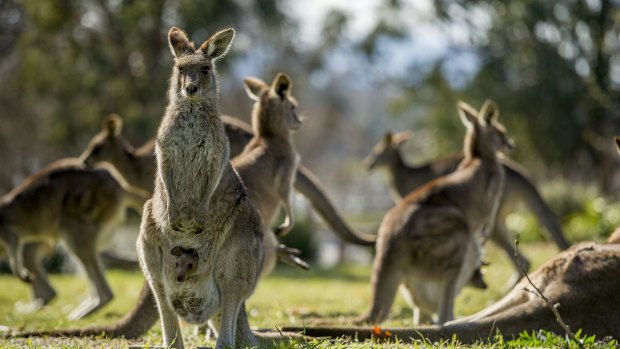By Alexandra Back
Drivers are nearly 70 per cent more likely to hit an animal in Canberra during winter than in summer, figures from insurer AAMI reveal.
And Friday night is the riskiest time for animal collisions.

Insurance data reveals winter is the riskiest time for animal collisions, especially with kangaroos.Credit: Jay Cronan
The figures match what the federal government – currently making improvements along certain roads – knows about the risks of driving in Canberra.
The northern third of Tuggeranong Parkway – listed as a hotspot – now has animal-proof fencing, and works are continuing on the remaining two-thirds.
The work includes installation of LED lighting, warning signs and traffic control devices to help mitigate risks from wild animals and other collisions.
AAMI analysed almost 20,000 claims made in 2015, of which 735 involved animals in the ACT.
That's a rise of 35 claims on the year before, while in 2013 there were 906.
According to the data, nine in 10 drivers who collided with an animal hit a kangaroo. Other animals included wallabies, wombats and dogs.
"Shorter days during winter mean we're on the roads more at times when animals are on the move, and combined with poor weather conditions and reduced visibility, make the chances of hitting an animal more likely," said AAMI spokesman Michael Mills.
Nationally, Queanbeyan was still the worst place for animal collisions, followed by Bendigo Victoria, Dingo Queensland, Singleton NSW and Goulburn.
"Drivers in Australia's capital should avoid driving at night, if possible, as it's hard to see animals. They also need to be attentive when behind the wheel at dawn and dusk as this is generally when wildlife, particularly kangaroos, are most active," Mr Mills said.
"It's vital that drivers keep a lookout for wildlife on the road, particularly on country roads and rural and regional areas near national parks and forests."
AAMI's data also shows most animal related crashes happen towards the end of the week, with Friday being the worst day for animal collisions.
Report accidents involving injured wildlife to Access Canberra on 13 22 81. Be sure to explain whether the animal is dead or alive and its exact location.